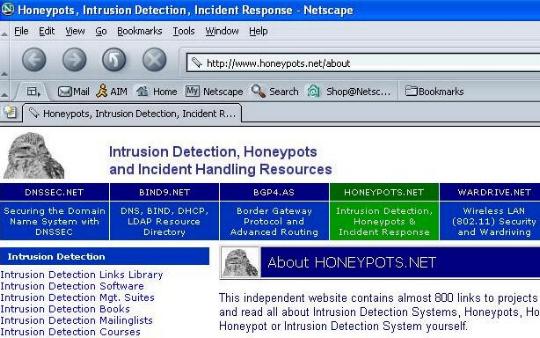
| HONEY POTS |  |
. |
"Honey
Pot" is not a new term, it was a slang expression during the Second
World War to describe attractive women used to entrap enemy officers into
revealing military information through social and romantic situations.
In the late 1990's it became a term also used by people trying to create
technical situations that would cause a hacker to focus on one thing, and
thereby miss the "target at risk", or , even better, reveal the hackers
identity so they could be "dealt with".
The term Honey Pot was first chosen by people who thought of the story of Pooh who stuck his head in a pot to get the last of the honey, and ended up getting trapped. |
| Counter
measures Honey
Pots
|
.Honey Pots defined
at www.honeypots.org
Jacco Tünnissen, Editor "Honeypots are programs that simulate one or more network services that you designate on your computer's ports. An attacker assumes you're running vulnerable services that can be used to break into the machine. A honeypot can be used to log access attempts to those ports including the attacker's keystrokes. This could give you advanced warning of a more concerted attack. " Honey Pots are employed in Intrusion Detection Systems (IDS) Honeypots.org is a portal that provides links to IT security companies that have services and products to help one use honeypots, and understand the community of Intrusion Detection in IT. |
www.honeypot.com is
an "independent website [which] contains almost 800 links to projects,
whitepapers, articles, presentations, howto's, and more.
Relax and read all about
Intrusion Detection Systems, Honeypots, Honeynets and Incident Handling."
http://www.honeypots.net/about
honeypots.com also lists
this witiger page www.witiger.com/ecommerce/honeypots.htm
as a resource

.
| Counter
measures Honey
Pots
Counter
Honey
Pots
|
"Honey pots can foil hackers" Some organizations have begun turning to an even more clever security trick. In their demilitarized zones, they set up dummy servers called honey pots, configured to look like key corporate systems. A honey pot might contain fake customer credit data, for instance. The idea of this is not that intruders will be fooled permanently. However, says Slodichak, they are likely to be fooled long enough that they will break out their system-cracking tricks to try to get into the dummy systems. By monitoring this activity, corporate security people will get an advance look at the cracker's arsenal before he or she realizes the deception and moves on in search of the real data. "The hacker community really hates honey pots," Slodichak says." Slodichuk
is Tom Slodichak, chief security officer at WhiteHat Inc. a Toronto security
consulting and training firm www.whitehatinc.com
|
| Honey
Pots
- how they can be used |
.
Greeks says " Thieves are using chat rooms to sell stolen credit-card details and advise others how to hack Web sites containing credit information. The thieves are not getting away with this completely, they are being tracked by Dr. Bill McCarty and his students at Azusa Pacific University who call their project the Honeynet Project. Greek explains "the Honeynet researchers set up computer systems, called "honeynets" or "honeypots," intended to be easy targets for hackers. The researchers then tracked the hackers to the IRC channels. " Prof. McCarty's page http://home.apu.edu/~bmccarty/ |
| Honey Pots |
Ivan adds "Several weeks
ago, I was watching a TV show called "Blog" with Chris Hansen on Dateline
NBC. This show is focused on methods used by the police in order to expose
and catch pedophiles. In this show, a police officer pretended to be a
13 year old girl who was using an online chat room looking for men over
the age of 18 in order to have sex with them. She would invite the pedophile
to her house, where he would be greeted by a young girl who would take
him to the backyard and would invite him to help himself with a drink while
she goes to put on her bathing suit for the hot tub. As the young girl
leaves "to go change" Chris Hansen approaches the man and starts questioning
him about his intentions. The police have recorded the entire conversation
and Chris quoted the pedophile’s statements in the online chat room. When
the pedophile tried to leave, he was confronted by several police officers
and arrested at the scene.The link for this web site is:"
There is also a short
clip of the episode on this web site.
|
| Honey
Pots it
is
|
|
| Honey
Pots it
is
|
Sunny posed
the following questions.
• Is a honey pot considered
entrapment if you want to press charges?
Sunny concludes
|
|
|
CONTACTIMAIN PAGE I NEWS GALLERY IE-BIZ SHORTCUTS I INT'L BIZ SHORTCUTS IMKTG&BUSINESS I TEACHING SCHEDULE IMISTAKES ITEXTS USED IIMAGESIRANKI |
| . |